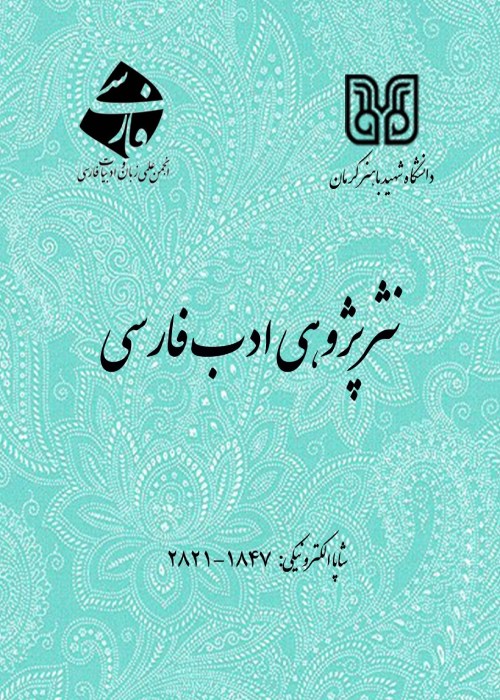An Analysis of the Syntactic Level of Letter 45 in Ghaem Magham Farahani’s Monsha’at Based on the Theory of Layer Stylistics
Author(s):
Article Type:
Research/Original Article (دارای رتبه معتبر)
Abstract:
Introduction
The structure of sentences and the order of words are two representative factors of the syntactic style of an author which are highly useful in explaining his personal style. Understanding the personal style of each author can be very helpful for readers in understanding the themes of his/her texts, knowing the character of the author and identifying his/her personal characteristics. Ghaem Magham Farahani is one of the greatest writers of the Qajar period whose personal style distinguishes him from his contemporary writers.
Methodology
Using the approach and theory of layer stylistics and the method of discourse analysis, the researchers have undertaken the study of syntactic level of the 45th letter in Ghaem Magham Farahani’s Monasha’at. They have attempted to identify the connection between meaning and the syntactic level in this text, and to explain to the readers what the syntactic factors are in this letter and how the syntactic structure of the text helps its theme.
Discussion
One of the most famous literary figures in Qajar period is Ghaem Magham Farahani, the Grand Vizier to Mohammad Shah Qajar. Thanks to his talent, artistry, and dedication, Ghaem Magham managed to write about the issues of his time in his Monsha’at with the use of a colloquial language and a literary texture which is more often than not compared with Sa’di’s Gulistan, since like Sa’di’s masterpiece, it is full of Arabic words, anecdotes, and proverbs. When these factors are combined with folklore literature, the result is a pleasant, attractive and dynamic prose. In a word, “Ghaem Magham is the Sa’di of his time” (Shamisa, 2014: 282). In Ghaem Magham’s prose, one can distinguish three styles: simple, intermediate and complicated, which have been very common in the previous periods. The prose contains Quranic verses, religious fables and hadiths which are signs of prolixity in texts (Khatibi, 2007: 58). One can also find elements of conciseness in sentences and the avoidance of complexity which are manifestations of simple and straightforward style (Rastegar Fasaei, 2018: 243). However, the most frequent style used in his writings is the simple style which is a recreation of the ancient simple and straightforward prose (Rahimian, 2008: 12), since his texts are intended to be simple and devoid of complexities in style and meaning.
It is the aim of stylistics to study the characteristics of texts with the attention to different linguistic periods, and then analyze these characteristics in relation to the authors who have used them in their texts. Accordingly, by analyzing the works of a writer or a period, researchers of stylistics can reveal many aspects about the texts, such as the perspective of the author, the social condition of the period, the discourse of the age, the orientation of the writer, creativities or imitations in the style of the writer, the author’s ideology and the dominant ideology of the period. However, due to the high number of these stylistic characteristics in the texts, the researchers have divided them into 5 categories and study each category independently. These five levels are phonetic, lexical, syntactic, semantic and pragmatic levels. Each of these levels are again divided into several sublevels which eventually make up the meta-levels when combined with each other. Syntax is the study of the relationship between linguistic forms in sentences, structure, order, syntagmatic and paradigmatic levels. The analysis of the syntactic level makes the reader capable of discovering the relationship between the syntactic structure and the thematic structure of a text. Some of the issues discussed on this level are the structure of the sentences, the length of the sentences, the order of sentences, moods in adverbs, adjectives and verbs, the verb tenses, adjuncts, the use of Arabic words and expressions. The researchers have undertaken the analysis of these elements in letter number 45 of Monsha’at by Mirza Abol-Ghasem Farahani.
Conclusion
The structure of sentences and clauses and the order of words in any text are representatives of the grammatical and syntactic style of that text which eventually lead the reader or the researcher of the linguistic behaviors to identifying the personal style of the writer. The analysis of the items under study showed that there is a relationship between the syntactic principles and the themes of the text. In this research, we studied the length of the sentences and analyzed the relationship between sentences from different perspectives. The findings showed that short sentences are used more than long sentences in this letter, which means that Ghaem Magham has used them for accelerating the expression of his thoughts. Short sentences are proper vehicles for transferring the purpose of the writer to the audience; however, whenever necessary, the writer has used longer sentences to explain and describe more. Therefore, the high frequency of short and concise sentences with independent thoughts in each sentence is indicative of the preference of meaning over verbosity in the mind of the writer and, as mentioned before, accelerates the expression of meaning. From among the four types of links in the sentences of this letter, the two types of equivalent and intertwined are more frequent than the other two, dependent and independent links. The use of these links brings more coherence and stronger relationship between the parts of the text and their meaning. The study of moods in this letter led to identifying Ghaem Magham’s ideology and individual character. In this regard, the findings show that in verbs, the indicative mood are more frequently used than imperative and subjunctive moods. This delineates that the writer of the letter has intended to narrate the incidents and phenomena; therefore, it reveals Ghaem Magham’s certainty in his text. The study of the mood in adverbs show his close relationship with the incidents; while the study of the mood in adjectives show the writer’s tendency toward different factors and people which usually express his power and certainty.
Keywords:
Language:
Persian
Published:
Journal of Letters and Language, Volume:26 Issue: 53, 2023
Pages:
281 to 313
https://magiran.com/p2632496
دانلود و مطالعه متن این مقاله با یکی از روشهای زیر امکان پذیر است:
اشتراک شخصی
با عضویت و پرداخت آنلاین حق اشتراک یکساله به مبلغ 1,390,000ريال میتوانید 70 عنوان مطلب دانلود کنید!
اشتراک سازمانی
به کتابخانه دانشگاه یا محل کار خود پیشنهاد کنید تا اشتراک سازمانی این پایگاه را برای دسترسی نامحدود همه کاربران به متن مطالب تهیه نمایند!
توجه!
- حق عضویت دریافتی صرف حمایت از نشریات عضو و نگهداری، تکمیل و توسعه مگیران میشود.
- پرداخت حق اشتراک و دانلود مقالات اجازه بازنشر آن در سایر رسانههای چاپی و دیجیتال را به کاربر نمیدهد.
In order to view content subscription is required
Personal subscription
Subscribe magiran.com for 70 € euros via PayPal and download 70 articles during a year.
Organization subscription
Please contact us to subscribe your university or library for unlimited access!




